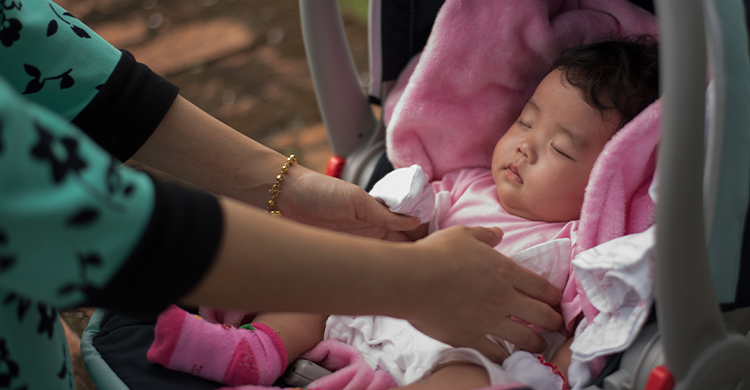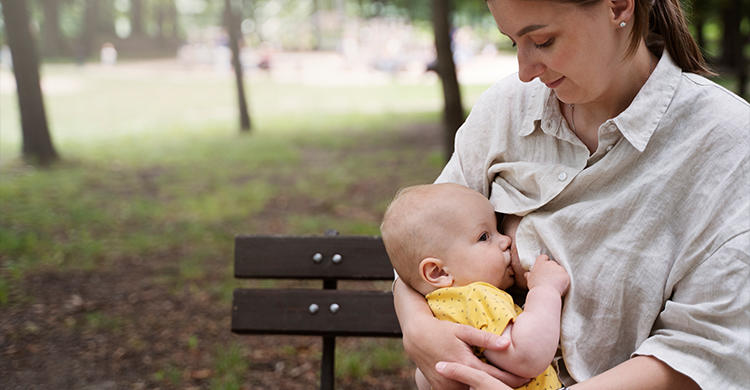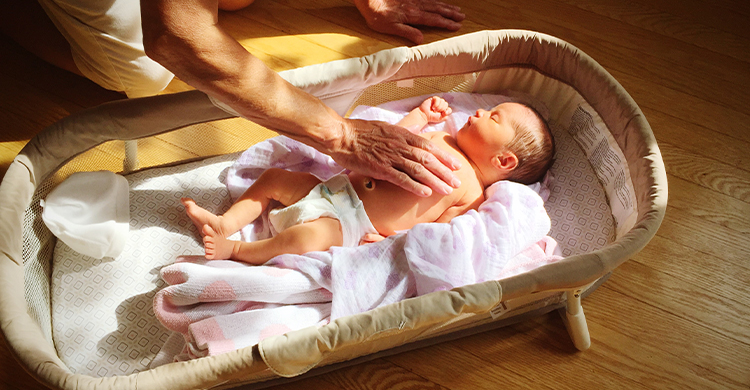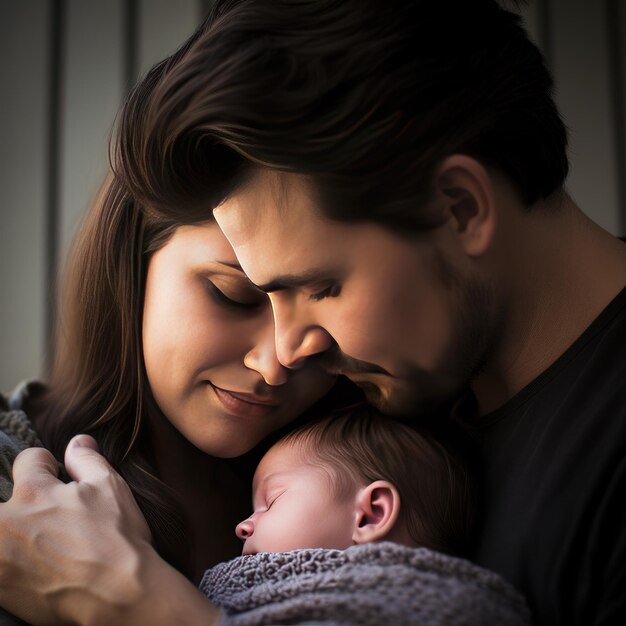How to Hold a Newborn Baby Safely?

Do you know how to hold a newborn baby? Pregnancy is one of the most beautiful yet challenging experiences a woman goes through in her life. Throughout the pregnancy, the mother dreams of holding the newborn baby. But do you know what is the best way to hold your baby? Various instances will require you to hold your baby, like picking the baby up from the crib, holding the baby when feeding, helping the baby burp, and comforting when the baby cries. Each of these instances requires you to hold the baby differently. We have prepared this comprehensive guide for all mothers wondering how to hold a newborn baby.
Proper Techniques for Holding a Newborn Baby
The nervousness the parents feel before learning to hold a newborn baby for the first time is widespread. But this blog is going to give simple steps by which you can easily hold your newborn. It is essential to support the neck and head while trying to hold the baby. The baby starts to develop head control after four months, and before that time, the parents have to make sure that the baby’s head doesn’t flop from front to back or side to side.
Cradle Hold for the Newborn Baby
Overview :
The cradle hold is a classic and comfortable way of holding a baby for parents who are learning to hold a newborn for the first time. It offers ample support to the baby and makes the baby feel closer to the parent.

Step-by-step instructions to perform the Cradle hold:
- To put the baby in cradle hold, you must start by sitting on a comfortable chair with enough back support. You can also put a soft pillow or cushion on your lap for the baby’s comfort.
- Start by gently laying the baby on its back across your forearm. Then, rest the baby’s head on the crook of your elbow and its body facing you. With the help of your other hand, support your baby’s bottom and leg.
- It is necessary to continuously support the baby’s neck and head with hands or forearms. The baby’s head should always be slightly higher than its body to avoid reflux.
- Make sure that the head of the baby is a bit tilted towards one side, which helps babies breathe properly.
- You can check that the baby’s arms and legs are relaxed and not tightly pressed against its body.
- The cradling time of holding a newborn baby is the best opportunity for the parents to build a bond with their baby. At this time, parents can make eye contact with their babies, sing lullabies, and gently rock them back and forth.
Football Hold for the Newborn Baby
Overview :
Holding a newborn baby while breastfeeding becomes more accessible when the baby is held in the football hold. The football hold is one of mothers’ most popular breastfeeding techniques. In a football hold, the mother tucks the baby under her arm like a football, positioning the baby at the side. For this hold, the mother can also put a pillow under the baby to provide support while breastfeeding.

Step-by-Step Instructions on Performing the Football Hold
- When holding a newborn baby in the football hold, use a comfortable chair and pillows to support your arms and the baby’s body if needed.
- Bring your baby to your side and tuck them under your arms like you would tug a football.
- For this hold, it is essential to check that the baby’s head, neck, and back have ample support.
- In football, the mother can support the baby’s head with her hands and then turn the baby’s face towards the breast for feeding.
- The baby’s whole body, with the hips and knees, should be well-supported and facing toward you.
- The mother can use her forearm to support the baby’s back and shoulders while her other hand supports the hips and bottom.
- After bringing the baby to the breast, ensure the baby has a deep latch. You might need to guide the baby’s mouth to your nipple.
- After each feed, remember to burp the kid with gentle pats and back rubs.
- The football hold can be helpful for those mothers who have large breasts, gave birth through cesarean section, and for babies who find it difficult to latch onto the breasts for feeding.
Cross-Cradle Hold for the Newborn Baby
Overview:
Women searching for how to hold a baby can refer to the cross-cradle hold. Cross cradle hold is a popular breastfeeding position that supports the baby and the breastfeeding mother. It is different from cradle hold. In cross cradle hold, if the mother is feeding from the right breast, then the left hand should be used to support the head of the baby and vice versa.

Step-by-step instructions on performing the cross-cradle hold
- When the mother breastfeeds the baby in the cross-cradle hold, she can sit comfortably on a chair with good back support.
- The use of soft pillows will provide support for the mother’s arms and back.
- In a cross-cradle, the opposite arm to the breast is used to feed the baby. For example, when feeding from the left breast, support from the right hand is taken to hold the baby.
- The baby’s head can be kept on the hands, with the thumb behind one ear and fingers behind the other.
- The hand placement should form a “C” shape to provide support for the baby’s neck and shoulders.
- To make the baby latch on the nipple, support the breast with the other hand to bring the baby’s mouth to the level of your nipple
- The mother can adjust the position as per the comfort of the baby when slowly learning how to hold a baby.
- With some practice, mothers can easily adapt to the cross-cradle position of breastfeeding.
- If you still find breastfeeding difficult, get help from a lactation consultant or support group of breastfeeding mothers.
Safety Tips for Holding a Newborn
These are the tips that every parent should keep in mind when learning how to hold a baby.
Supporting the Head and Neck
When holding a newborn baby, parents can keep the head of the baby in the crook of their arms. While holding a newborn, cradle its head in the crook of your arm, ensuring it’s always supported. Use your hand to support the neck, aligning it with the spine gently. Always maintain a secure grip and avoid sudden movements to protect their delicate head and neck.
Ensuring Comfort and Security
- For the baby’s utmost comfort and safety, the mother should have a gentle and firm grip on the baby when holding.
- Sharp and potential harm-causing objects should be kept far away from the surroundings of the newborn.
- Sudden movements can startle the baby, so while holding the baby make slow and gentle movements.
- Address baby’s cues and needs, such as hunger or discomfort quickly.
- A calm and soothing environment helps in creating a nurturing atmosphere for the baby.
Awareness of Baby’s Signals
Parents should be aware of their baby’s signals for a responsive caregiving and nurturing parenting experience. The primary mode for a kid’s communication is their cries, the expressions on their face and their body movements because they can not verbalize their needs and issues. The cries of a baby signal their hunger, discomfort, tiredness, and need for attention and love. Babies use facial expressions like smiling when feeling content and happy and frowning when they are uncomfortable. When babies are trying to reach for objects, it means they are liking the stimulation and when they get enough stimulation, they turn their heads away. Parents should act promptly to their kid’s signals to build trust in them and make the baby feel secure. As time passes parents become more attuned to their baby’s signals and needs.
Bonding Through Holding
1. Skin-to-skin Contact
The skin-to-skin contact between parents and their baby is also known as kangaroo care which helps in developing a deep bond between parent and the baby. In this practice, parents hold the naked baby against their bare chest. This skin-to-skin contact not only provides warmth and comfort but is also helpful in regulating baby’s temperature, heart rate and breathing. This activity boosts the oxytocin levels and develops feelings of love and attachment in the parents and the baby.
2. Eye Contact and Communication
The eye contact between parents and baby plays a crucial role in communicating bonding. When the parents hold the baby and make eye contact with them, they create a powerful bond. The eye contact makes the baby feel seen, understood and secure. With the help of eye contact parents can understand and interpret, the baby’s cues and act accordingly.
3. Gentle Touch and Cuddling
To develop a great bond with the baby, parents should also do gentle touching and cuddling to develop an emotional connection. The physical contact between parents and kids releases oxytocin, the “love hormone”, promoting feelings of trust and affection. Cuddling time also regulates the nervous system of the baby which helps in reducing stress and providing relaxation. Cuddling symbolizes a safe womb-like environment for the baby. Gentle touches to the baby communicate the feelings of love, reassurance and acceptance. The cuddling sessions between parents and the baby lead to healthy attachment that lays a solid foundation for their future relationship.
Conclusion
Learning how to hold a newborn baby is an essential skill for every new parent. Parents can practice holding techniques like cradle, football, and cross-cradle holds to ensure the safety and comfort of their baby. Development of emotional bonding can be done through a nurturing environment which will further help in promoting a strong and healthy parent-child relationship.
Also Read,






